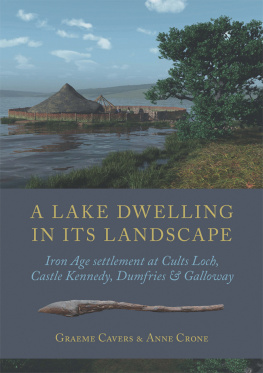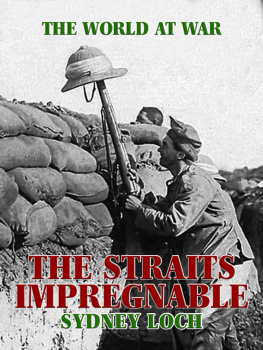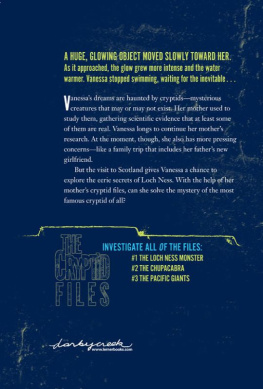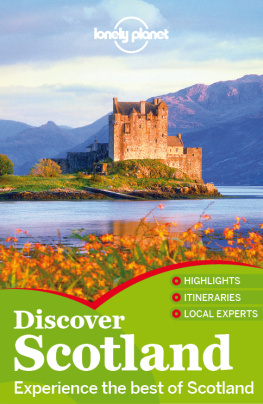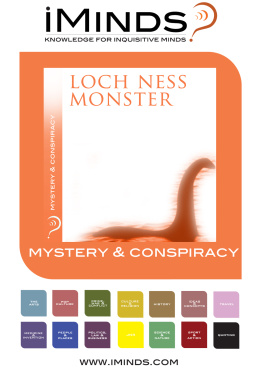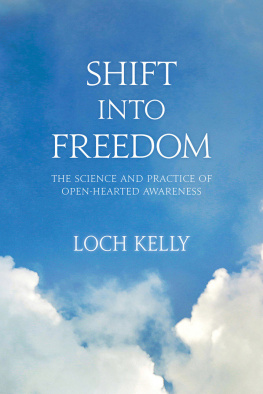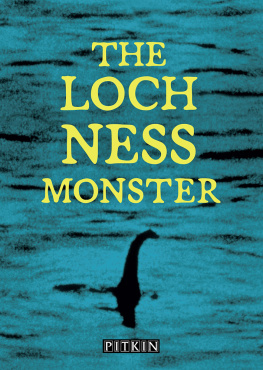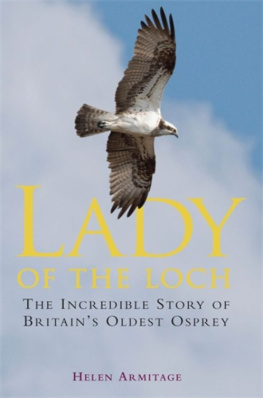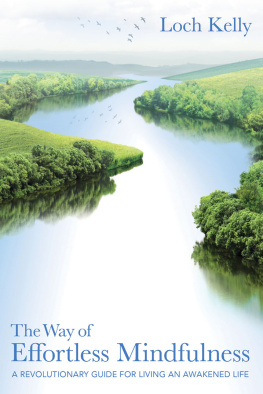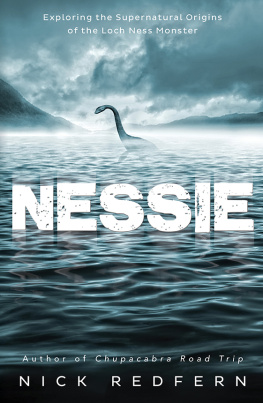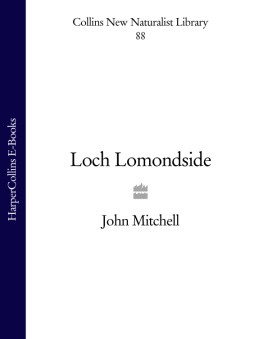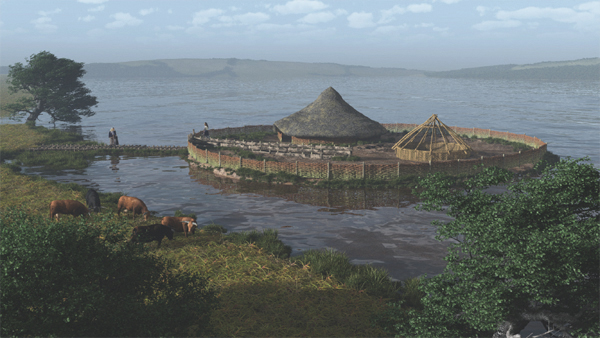
A L AKE D WELLING IN ITS L ANDSCAPE
Frontispiece; Cults Loch 3 crannog viewed from the NW. The reconstruction shows the crannog encircled by a light wickerwork fence, with an oak plank facade on either side of the entrance onto the settlement. A post-built causeway connects the crannog to the shore, sediments and vegetation gradually building up on either side of it. Within the crannog Structure 2 is occupied, reconstructed as an archetypal Iron Age roundhouse with conical thatched roof and wickerwork walls. A post-and-plank wall divides the interior, while an entirely speculative smaller roundhouse is being constructed in the S half of the settlement. Evidence for many of the structures in the reconstruction is presented in this monograph but much is of course, speculative. Nonetheless, the reconstruction evokes the size and spaciousness of the crannog as well as its proximity, and consequent vulnerability, to the shore (created by Marcus Abbott, York Archaeological Trust).
A Lake Dwelling in its Landscape
Iron Age Settlement at Cults Loch, Castle Kennedy, Dumfries & Galloway
Graeme Cavers & Anne Crone
Published in the United Kingdom in 2018 by
OXBOW BOOKS
The Old Music Hall, 106108 Cowley Road, Oxford, OX4 1JE
and in the United States by
OXBOW BOOKS
1950 Lawrence Road, Havertown, PA 19083
Oxbow Books and the authors 2018
Hardback Edition: ISBN 978-1-78570-373-7
Digital Edition: ISBN 978-1-78570-374-4 (epub)
Mobi Edition: ISBN 978-1-78570-375-1 (mobi)
A CIP record for this book is available from the British Library and the Library of Congress
All rights reserved. No part of this book may be reproduced or transmitted in any form or by any means, electronic or mechanical including photocopying, recording or by any information storage and retrieval system, without permission from the publisher in writing.
For a complete list of Oxbow titles, please contact:
| UNITED KINGDOM | UNITED STATES OF AMERICA |
| Oxbow Books | Oxbow Books |
| Telephone (01865) 241249 | Telephone (800) 791-9354, Fax (610) 853-9146 |
| Email: | Email: |
| www.oxbowbooks.com | queries@casemateacademic.com |
Oxbow Books is part of the Casemate Group
Front cover: Reconstruction of Cults Loch 3 crannog viewed from the NE (created by Marcus Abbott, York Archaeological Trust) Back cover (top): Cults Loch, showing the excavation of the crannog (Site 3) underway, with Cults Loch crannog Site 1 in the background; (bottom left): excavation of the Cults Loch crannog (Site 3) in progress in 2010; (bottom right): souterrain, post-excavation
Acknowledgements
First and foremost we are grateful to John Dalrymple, Earl of Stair for permission to excavate around Cults Loch and to Paul Hutchinson of Stair Estates for facilitating access on to the tenant farmers lands. The project would not have been possible without grant aid from Historic Scotland; this was managed initially by Noel Fojut and latterly by Rod McCullagh, and monitored by Pauline Megson and John Malcolm. The Society of Antiquaries of Scotland lent their support in the form of a grant for the gradiometry surveys, while AOC Archaeology Group provided staff, equipment, vehicles and administrative support every year. The schools programme and associated exhibition and activities at Stranraer Museum were made possible through funding from LEADER II and Jennifer Thoms guided entertaining and informative visits to the crannog. Staff at Stranraer Museum were always supportive, John Pickin providing help in a variety of guises over the years, from curator to field archaeologist to illustrator. The offsite coring programme was initiated by Tony Brown of Southampton University who was assisted in the field by Laura Basell. The loch sediments from Cults Loch were then examined as part of a postgraduate study, Human islands palaeoenvironmental investigations of crannogs in south-west Scotland and Co. Fermanagh, Northern Ireland , by Thierry Fonville and under Tonys supervision.
The fieldwork teams varied from year to year and are acknowledged below. However, two people were present in every season of fieldwork and their contributions are singled out for special mention; Tessa Poller gave of her holiday every year to dig at Cults Loch and also undertook the geophysical surveys of the terrestrial sites, while Alan Duffy provided stalwart logistical support ever year.
2007 Danielle Gorke, Gemma Hudson, Heather James
2008 Vivian Delf, Maria Grabowska, Hana Kdolska, Sarah Lynchehaun, and Diana
2009 crannog Vivien Delf, Robert Lenfert, Pat Martin, Katie McFarlane, Pauline Megson, Stacey Turnbull, Fiona Watson
2009 terrestrial Vicky Clements, Vivien Delf, Rob Engl, Pat Martin
2010 crannog John Barber, Vivien Delf, Anne Dunford, Thierry Fonville, Heather James, Robert Lenfert, Pat Martin, Katie McFarlane, Ann Sackree, Glenis Vowles
2010 terrestrial Vicky Clements, Alan Dalton, Thomas Legendre
2011 terrestrial Rob Engl, Thierry Fonville, Kevin Paton, Stephen Potten
During the post-excavation programme the authors have been helped by valuable discussions with John Barber, Dave Cowley, Strat Halliday and Fraser Hunter. Jane Murray shared her knowledge of Cults Loch gained during her undergraduate dissertation and helped us to locate the Reverend George Wilsons manuscripts at the National Museum of Scotland. Jamie Humble and Gemma Hudson have prepared all the illustrations except for the artefacts which were drawn by Alan Braby and John Pickin. We are grateful to the Trustees of the Mouswald Trust who provided financial support for the illustration of long unseen objects in the collections of Stranraer Museum and the National Museums of Scotland.
Last but not least we would like to acknowledge the role of other founder members of SWAP, the Scottish Wetland Archaeology Programme, without whose passion and commitment the Cults Loch Landscape project would not have happened. They are John Barber, Ciara Clarke, Alex Hale, Jon Henderson, Rupert Housley, Rob Sands and Alison Sheridan.
The acknowledgements of the individual specialists are presented below;
Anne Crone would like to thank David Brown, Queens University Belfast, for his help in dendro-dating the Cults Loch 3 timbers.
Fraser Hunter, Dawn McLaren and Gemma Cruickshanks are grateful to John Pickin for extensive advice on collections in Stranraer Museum and Monreith House, to Ann Ramsbottom and Alan McFarlane for assistance in Stranraer, Katinka Stentoft and Jane Flint for information on Glasgow collections, Joanne Turner for listings of collections in Dumfries, and Dr Susie Kirk for analysis of the Carleton ingot.
Jackaline Robertson is grateful to Dr Allan Hall who mentored her work on the environmental assemblage from Cults Loch 3, providing practical guidance on issues of identification and interpretation, and editing the final report.
Introduction
The research framework
In 2005, the members of the Scottish Wetland Archaeology Programme (SWAP) hosted the Wetland Archaeological Research Programme (WARP) conference in Edinburgh, bringing together practitioners of wetland archaeological research from all over world (SWAP 2007). In European terms, the timing of the conference was ideal; the major development of infrastructure in Ireland in the early 21st century had meant that some of the most important wetland discoveries had recently been made, while developments in continental Europe were continuing to push the boundaries of a long tradition of prehistoric settlement archaeology. Archaeologists specialising in wetland archaeology were developing new ways of integrating wet and dry sources of evidence to find alternative ways of thinking about wetlands (eg Van der Noort & OSullivan 2006), and both practical and theoretical aspects of the study of waterlogged archaeology were healthy and fertile grounds. As the home of Robert Munro, one of European wetland archaeologys pioneers (Munro 1882; 1890) Edinburgh seemed an apt venue for an international gathering of wetland archaeologists, and the conference took the opportunity to celebrate Scotlands rich wetland archaeological resource.
Next page
